Logos are undoubtedly a crucial part of any brand’s identity and serve as a visual illustration of the brand’s values, mission, and vision. Customers often notice the logo first before they go anywhere to check out other things. And, definitely, it can create a positive and lasting impression. Well! There are different types of logos that companies can use, each with its own unique characteristics and design.
From wordmarks to vector and personalized marks, each type of logo has its own strengths and weaknesses. In this article, we will discuss some common but popular types along with their advantages and ways of using to create a strong brand identity.
Suggested Article– Creative Logo Design Ideas.
Wordmark
Wordmark logos refers to the logo design that includes the brand’s name or a word or phrase, typically personalized in a unique way to represent the brand’s identity. This type of logo focuses on typography and font selection to generate a distinct and recognizable brand image.
Some of the popular examples of wordmarks/logotypes include the logos of Coca-Cola, FedEx, Google, and Disney.
Advantages
- Memorable and easy to recognize.
- Can convey the brand’s personality and style through typography.
- Versatile and suitable for a variety of applications.
Disadvantages
- May not be as visually appealing or interesting as other logotypes.
- Relies heavily on the brand’s name and may not be as effective for new or unknown brands.
- Can be tough to create a truly unique design with only typography.
When to Use
Wordmark logos are a good choice for companies with well-established brand name that wants to create a clean and minimalistic image. They work well for businesses with short names. That’s why anyone can easily remember and recognize them. Besides, they are suitable for brands that want to convey a professional and straightforward image, such as law firms or accounting firms.
Suggested Article– Logo Design Process.
Lettermark
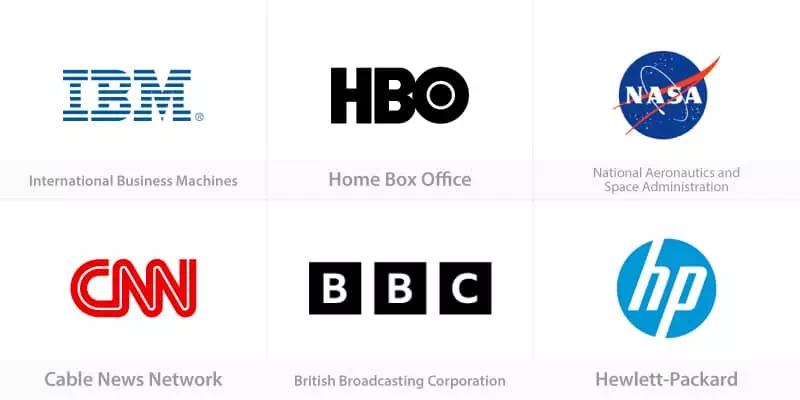
A letter mark is a type of logo consisting of the initials or acronyms of a brand’s name. Letter marks are also known as monogram logos. This type of logo design is a typography-based logo that typically uses custom fonts to create a unique and recognizable design. Unlike wordmarks, letter marks do not spell out the brand’s name in full. Instead, they rely on typography to create a unique visual identity that represents the brand.
Examples of letter marks include the logos of IBM, HBO, NASA, and CNN.
Advantages
- Compact and easy to remember.
- Can effectively represent a long brand name in a concise manner.
- Ideal for brands with long or difficult-to-pronounce names.
Disadvantages
- May not be as visually interesting or memorable as other logotypes.
- Can be difficult to create a truly unique design with only typography.
- May not effectively represent a brand’s personality or values.
When to Use
For brands with lengthy or intricate names that could be challenging to recall or pronounce, a letter mark works best. It is also perfect for businesses that desire a clear, manageable logo that works well in a number of contexts. For businesses looking to express a strong sense of personality or values through their logo design, letter marks might not be as effective.
Pictorial Mark
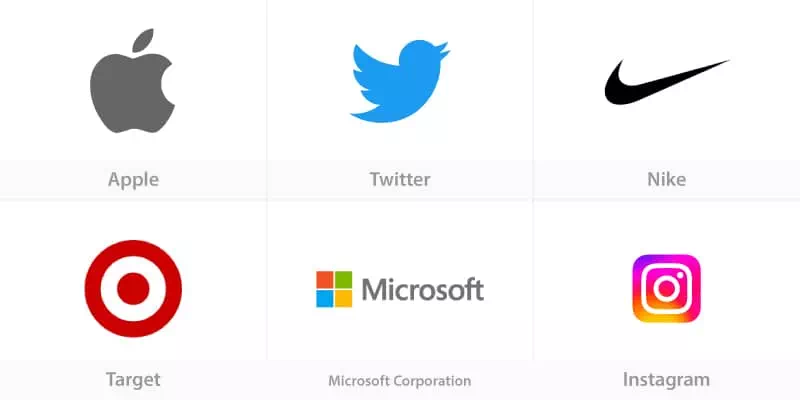
A pictorial mark or logo symbol is a type of logo that uses a graphic or visual symbol to represent a brand. Unlike wordmarks or letter marks, pictorial marks do not use typography or text to spell out the brand’s name. Instead, they rely solely on an image to create a memorable and recognizable design.
Examples of pictorial marks/logo symbols include the logos of Apple, Twitter, Nike, and Target.
Advantages
- Highly memorable and recognizable.
- Conveys the brand’s values and personality.
- Can be scaled easily and used in a variety of applications.
Disadvantages
- May not be as straightforward or immediately clear as other logotypes.
- Can be challenging to create a truly unique design that stands out from competitors.
- May not effectively represent a brand with a long or complicated name.
When to Use
Pictorial mark logos are ideal for businesses with a simple name or a recognizable abbreviation as they help to create a memorable brand image. These logos are particularly effective when targeting a younger demographic as they are often more visually oriented and respond well to strong, recognizable imagery. However, businesses with a long or complicated name may want to consider using a different logotype.
Suggested Article–Best Band Logo Design Ideas.
Vector Logos
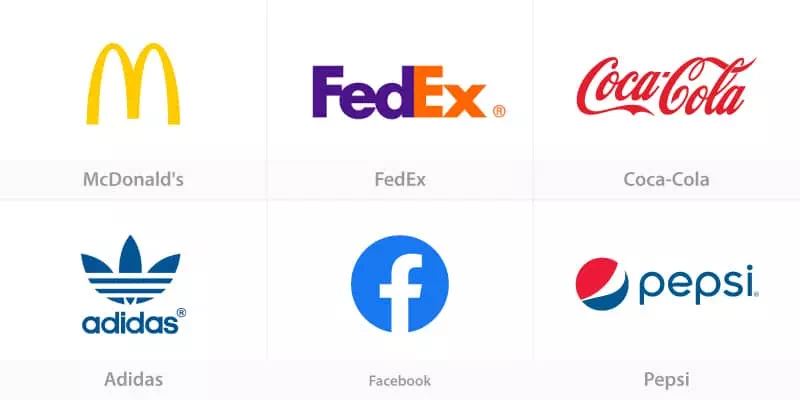
Vector logos refers to logo designs created using vector graphics software like Adobe Illustrator. They are distinct from other logotypes as they use mathematical equations and geometric shapes, instead of raster images or pixel-based graphics. This allows vector logos to be resized without losing clarity or quality, making them versatile and ideal for various branding applications.
McDonald’s, FedEx, and Coca-Cola are some of examples of vector logos.
Advantages
- Designers can scale up or down without losing quality.
- Logos may work better with simple gradients or solids.
- Ideal for use in a variety of applications, from small business cards to large billboards.
Disadvantages
- May require specialized software or expertise to create or edit.
- It can be more time-consuming to create than other types.
When to Use
A vector logo is best used for brands that need a logo that can be easily scaled up or down without losing quality or clarity. It is also perfect for brands that require a logo that designers can easily edit or modify. However, a vector logo may not be as efficient for brands that want a logo with a more complex or visually interesting design. As vector logos are typically more simplistic in design.
Abstract Logo
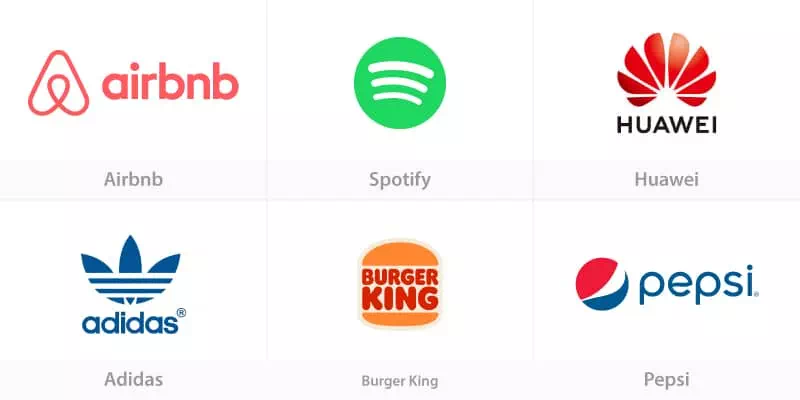
Abstract logos refer to the type of logo that uses abstract shapes, forms, and patterns to produce a unique and memorable design. Unlike other logotypes, these logos do not rely on particular images or symbols to represent a brand. Instead, they avail more generalized shapes and patterns to develop a design that is open to interpretation.
Examples of abstract logos include the logos of Pepsi, Adidas, and Airbnb.
Advantages
- Can be more versatile and adaptable to a variety of branding applications.
- Allows for more creative freedom in the design process.
- Can be memorable and distinctive due to the unique and abstract nature of the design.
Disadvantages
- May not be immediately recognizable or clearly represent the brand.
- Can be more challenging to design effectively, as the design must balance abstractness with a clear brand representation.
- May not be as effective for brands that require a more literal representation of their products or services.
When to Use
Vector logos are an ideal choice for businesses that require a logo that can be rescaled without losing its quality or clarity. They are typically simpler in design, and complex graphics may be complicated to build using vector-based software. In such cases, a raster-based logo design may be more suitable.
Combination Mark
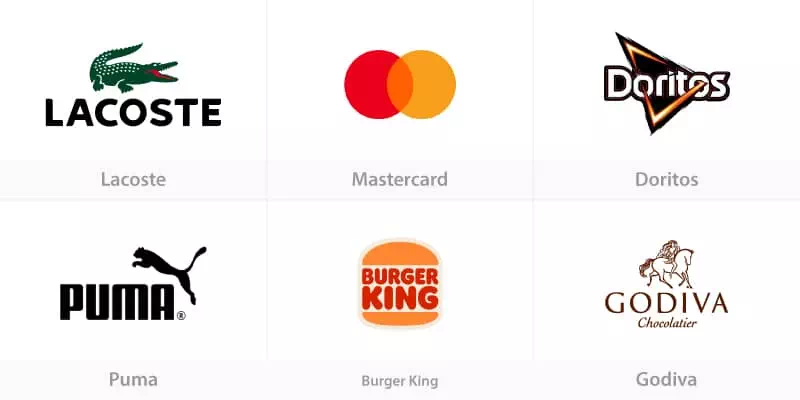
A Combination Mark logo is a type that combines a symbol or icon with a wordmark or letter mark. It is a popular logo style because it allows companies to incorporate both visual and textual elements in their logo design, making it highly versatile and flexible.
Burger King, Lacoste, and Mastercard are some of examples of combination marks.
Advantages
- Can be highly effective for establishing brand recognition.
- Allows for both a visual symbol and a textual representation of the brand.
- Can be versatile and adaptable to a variety of branding applications.
Disadvantages
- Can be more complex and challenging to design than other logotypes.
- May be less memorable or distinctive if not executed effectively.
- Can be more difficult to scale down and may lose clarity or legibility at smaller sizes.
When to Use
A combination mark is a perfect option for businesses that require both a visual symbol and a text-based representation in their logo design. It’s been a versatile choice for many individuals for its adaptation capabilities with different brands. If a company intends to convey a highly specific or special brand identity through its logo, then a combination mark might not be the utmost choice.
Imagery-based Mark or Symbol
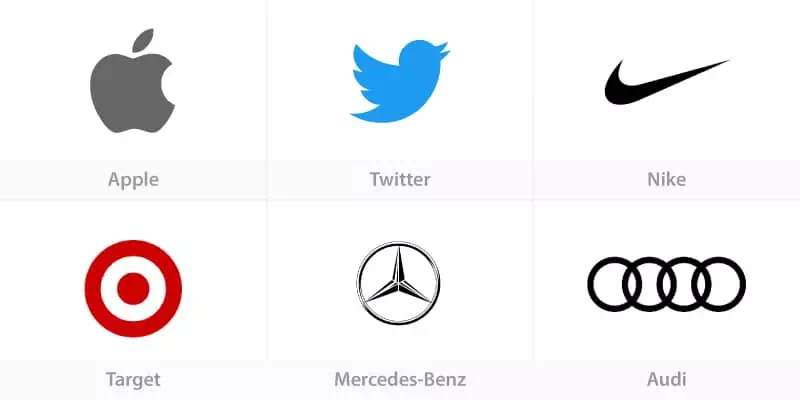
A sort of logo known as a pictorial mark or logo symbol uses a graphic or visual symbol to represent a company. Pictorial marks do not use typography or text to spell out the brand’s name, unlike wordmarks or letter marks. Instead, to produce a memorable and recognized design, they rely entirely on one image.
The logos of Nike, Target, Twitter, Apple, and other companies are examples of pictorial marks or logo symbols.
Advantages
- Incredibly recognized and memorable.
- May use visuals to successfully communicate the brand’s values, personality, and mission.
- May be utilized in many applications and scaled quickly.
Disadvantages
- Possibly not as obvious or straightforward as other logotypes.
- Developing an original design that distinguishes out from rivals might be difficult.
- It could be difficult to represent a brand with a long or difficult name.
When to Apply
The best brands to utilize a pictorial mark or logo symbol are those that have a distinct visual identity or desire to use their logo to represent a certain idea or image. Additionally, it is perfect for businesses that want their logos to be unique and instantly recognized. A graphical mark or logo symbol, however, might not be as effective for companies with long or difficult names or who rely primarily on words to represent their brand.
Scalable Logos

A sort of logo made with vector graphics software, like Adobe Illustrator, is called a vector logo. Vector logos are made utilizing mathematical equations and geometric shapes, as opposed to other sorts of logos, which could make use of raster imagery or pixel-based visuals. This makes vector logos perfect for usage in a number of applications since they can be scaled up or down without sacrificing quality or clarity.
The emblems of McDonald’s, FedEx, and Coca-Cola are a few examples of vector logos.
Advantages
- Scalable both up and down without sacrificing clarity or quality.
- With simple gradients or solids, they might perform better.
- Ideal for a range of uses, from little business cards to substantial billboards.
Disadvantages
- Possibly difficult to develop or change without specific tools or knowledge.
- It could take longer to make than other varieties.
When to Apply
For organizations that need a logo that can be readily scaled up or down without losing quality or clarity, a vector design is a perfect option. Additionally, it is perfect for businesses who need a simple-to-edit or modify logo. However, because vector logos are often more basic in form, they might not be as beneficial for firms who desire a logo with a more complicated or aesthetically appealing design.
Conceptual Logo

In order to produce a distinctive and memorable design, an abstract logo employs abstract shapes, forms, and patterns. Contrary to other forms of logos, abstract logos don’t rely on particular pictures or symbols to represent a company. Instead, they produce a design that is open to interpretation by using more ambiguous shapes and patterns.
The logos for Pepsi, Adidas, and Airbnb are a few examples of abstract logos.
Advantages
- Can be more flexible for different branding purposes and more versatile.
- Gives designers additional room for creativity during the design process.
- Due to the distinctive and abstract quality of the design, it may be memorable and recognizable.
Disadvantages
- May not clearly represent the brand or be instantly recognizable.
- Effective design can be more difficult to achieve since it must strike a balance between abstraction and a distinct brand representation.
- For brands that need a more accurate representation of their goods or services, it might not be as effective.
When to Apply
Businesses that aim for a unique and memorable logo design should consider using an abstract logo. This type of logo is particularly suitable for companies that require a versatile logo design to be used across different branding contexts. However, if a brand relies heavily on specific imagery or symbols to communicate its identity, an abstract logo may not be as effective.
The Emblem
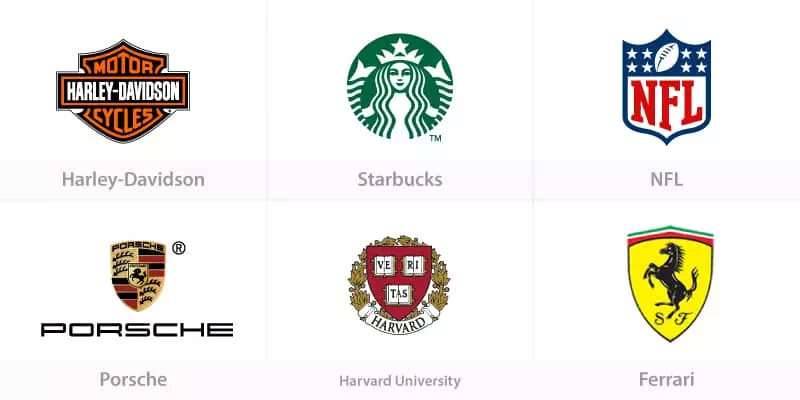
A logotype known as an emblem combines text and images into a single design, usually inside of a circle or another geometric shape. While the picture or symbol is frequently positioned in the center or on the shape’s periphery, the text is frequently placed inside the shape. Emblem logos are frequently linked to more established or vintage corporations, such as colleges, sports teams, and governmental agencies.
The emblem logos for Harley-Davidson, Starbucks, and the NFL are a few examples.
Advantages
- Might give a sense of authority, history, or tradition, which is crucial for some brands.
- Frequently extremely intricate and aesthetically pleasing, which can make the brand stand out.
- Can work well for businesses that want to combine text and images in one design.
Disadvantages
- At smaller sizes, it may become more challenging to scale down and lose clarity or legibility.
- Possibly less suited to a wide range of branding purposes.
- Compared to other logo forms, they can be more complicated and difficult to design.
When to Apply
The greatest brands to employ an emblem logo are those that seek to imply tradition, history, or authority. Additionally, it works well for businesses that want to combine text and images in one design. For brands that need a more changeable or versatile logo design or that wish to project a more contemporary or minimal company identity, an emblem logo might not be as effective.
Compound Mark

Combination marks are a particular kind of logo that mix text with images or symbols to offer a distinctive and memorable design. There are different ways to arrange the text and image/symbol, with the text frequently appearing next to or below the image or symbol. It allows for both a visual sign and a linguistic representation of the brand, which can be quite useful for building brand identification.
The logos for Burger King, Lacoste, and Mastercard are a few examples of combination marks.
Advantages
- May be quite successful in building brand recognition.
- Allows for the brand to be represented both visually and textually.
- Adaptable to a wide range of branding applications and versatile.
Disadvantages
- Compared to other logo forms, they can be more complicated and difficult to design.
- Unless done well, it could not be as memorable or distinctive.
- At smaller sizes, it may become more challenging to scale down and lose clarity or legibility.
When to Apply
The greatest brands to utilize a combination mark for in their logo design are those that desire both a visual emblem and a textual representation of their company. It works well for businesses that desire a logo that can be used for a range of branding initiatives. For firms that need a more abstract or minimalist logo design or that wish to communicate a very precise brand identity through their logo, a combination mark might not be as effective.
Personalized Mark

The letters of a brand’s name are used to create a distinctive and recognized design in a monogram logo. For firms with longer or more intricate names, monogram logos can be particularly powerful in building brand recognition. They can evoke a feeling of elegance and sophistication, which is why luxury businesses and fashion houses frequently utilize them.
Louis Vuitton, Chanel, and Gucci are a few brands with monogrammed emblems.
Advantages
- May work wonders for building brand recognition, especially for companies with long or difficult names.
- Offers a feeling of sophistication and elegance, which can be vital for some brands.
- Adaptable to a wide range of branding applications and versatile.
Disadvantages
- If not done well, may not be as memorable or distinctive as other logo forms.
- Making a distinctive design that stands out from other monogram logos can be more challenging.
- For firms that need a more literal or descriptive logo design, it might not be as effective.
When to Apply
In order to make the brand’s name easier to remember and recognize, monogram logos are best suited for businesses with longer or more complex names. It works well for high-end firms or fashion houses that want their logo to exude sophistication and elegance. If a brand needs a more precise or descriptive identity, a monogram logo might not be as effective.
You may also read– Common Logo Design Mistakes.
Last Words
As there are many distinct options available, it can be really challenging to decide only one style for your brand. Each type has particular benefits and drawbacks. Wordmarks and letter marks are ideal for businesses that wish to present their company name in a simple, elegant manner.
Additionally, pictorial markings are perfect for businesses that wish to express a statement or symbol that best embodies their brand. Combination marks are a common option because they mix text and images to produce a powerful visual impression, which makes them a good option for brand awareness. Initials are used to create a unique and enduring design in monogram logos.
Furthermore, 3D logos employ three-dimensional design components to convey depth and dimension. Your brand can make a strong and enduring impression that will help it stand out in a crowded market by selecting the appropriate type of logo. Decide wisely and choose the font that best represents your brand.










